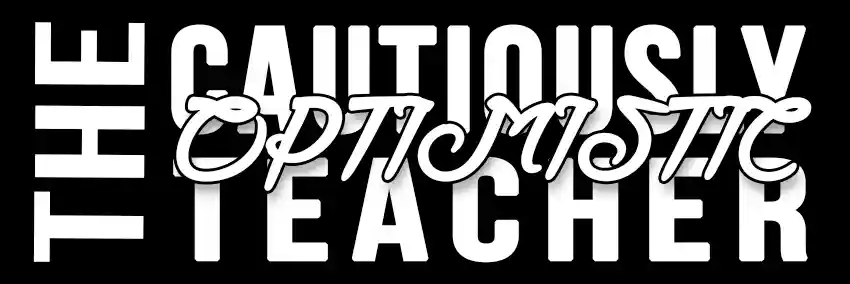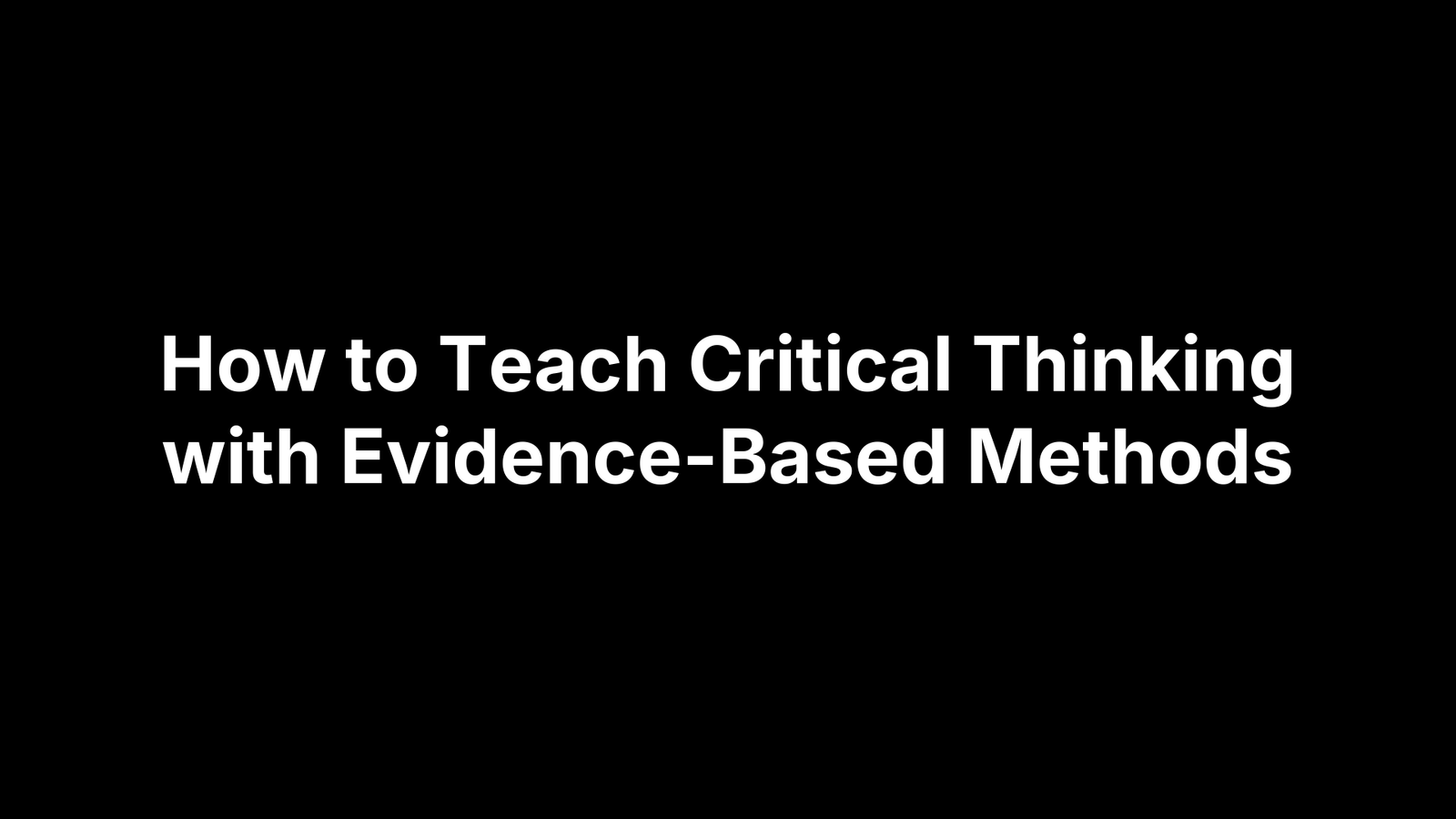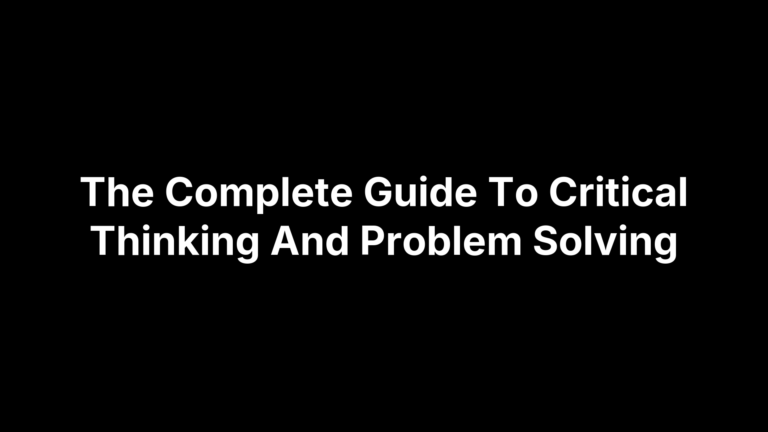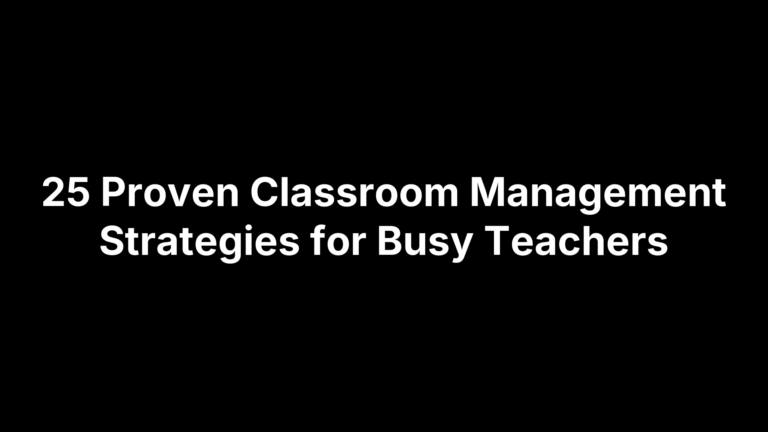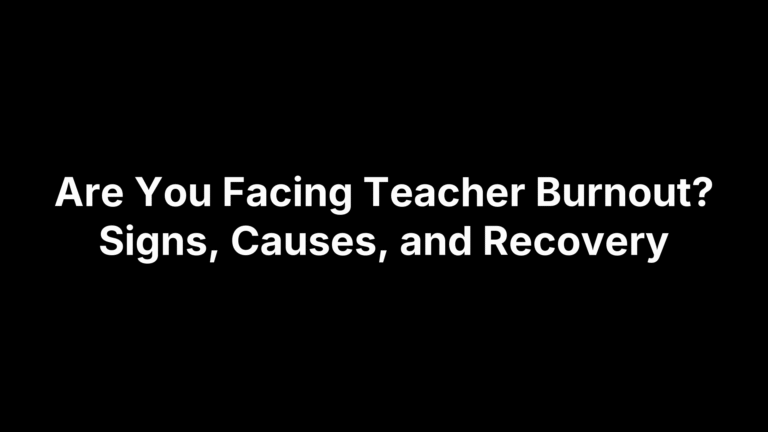How to Teach Critical Thinking with Evidence-Based Methods
You want students who can weigh evidence, spot shaky claims, and explain their thinking—but “teach critical thinking” often feels like one more vague mandate on an already crowded plate. Generic posters and one-off activities don’t stick, transfer is rare, and grading for reasoning can feel subjective. The good news: you don’t need a new course. You need clear definitions, smart routines, and short, repeatable moves embedded in what you already teach.
This guide distills what research consistently shows works: make critical thinking concrete and domain-specific, build the background knowledge students need to think with, model and label the steps experts use, and practice for transfer with structured comparisons. You’ll see how to teach argumentation explicitly, surface biases quickly, ask questions that elicit reasoning, and assess the thinking you value. Everything here is classroom-ready, time-aware, and adaptable—with optional ways to use AI as a planning assistant, not a crutch.
We’ll walk through a step-by-step playbook: define critical thinking for your subject and grade, identify essential knowledge and vocabulary, create a culture that rewards reasoning, make thinking visible with worked examples and subgoals, use problem comparison and analogies, teach claim–evidence–reasoning and argument mapping, address fallacies and biases, elevate discussions with better questions, and more—from lateral reading to retrieval practice, UDL-driven differentiation, aligned assessment, spiraling, and ready-to-use activities you can launch tomorrow. Let’s get practical.
Step 1. Define what critical thinking means in your subject and grade
Start by pinning down what “critical thinking” means in your class right now. Research shows the most effective approach is domain-specific: solid reasoning in ELA isn’t identical to validity in chemistry or algebra. So, when you plan how to teach critical thinking, write a short, task-based definition your students can do and you can assess—then teach to that.
In [subject], grade [X], students will [task] by [method] using [criteria].
- History: “Source” a primary document—identify author, purpose, audience—and judge reliability.
- Science: Evaluate an experimental claim—check controls, sample size, and alternative explanations.
- Math: Select a strategy, justify each step, and check reasonableness of the result.
- ELA: Analyze an editorial—state the claim, assess evidence quality, and identify assumptions.
Calibrate to your grade with clear success criteria and verbs students recognize. Keep 3–4 concise can-do statements on the board or syllabus and use them to plan prompts, feedback, and rubrics. If you can’t observe it in student work, refine the definition before you try to teach critical thinking.
Step 2. Identify the essential background knowledge and vocabulary students need to think with
If you want to know how to teach critical thinking that actually shows up in student work, start with the knowledge students will think with. Research highlights that domain knowledge fuels reasoning: it helps students recognize problem types, lightens working-memory load, and is often required to apply “general” principles. For example, you can tell students to source a document, but to evaluate a 1779 letter from General George Clinton to George Washington, they need concrete background on the Revolutionary War to make sense of purpose, audience, and reliability.
- Run a quick knowledge audit: List the facts, concepts, and examples a student must know to succeed on your Step 1 task.
- Prioritize essential terms (8–12 max): Teach student-friendly definitions with examples and non-examples; reuse the words in prompts and rubrics.
- Preload efficiently: Use a short reading, timeline, or demo plus a 3-question retrieval warm-up to activate/secure background knowledge.
- Probe readiness: Give a 2-minute check (sort, match, or cloze). If shaky, reteach briefly before asking for higher-level thinking.
Unit:[Topic] | Big ideas:[…] | Prior knowledge:[…] | Essential vocabulary:[…] | Misconceptions:[…] | Anchor examples:[…]
Step 3. Create a classroom culture that rewards reasoning, curiosity, and intellectual risk-taking
Before any routine works, students have to believe that thinking out loud is safer—and more valuable—than guessing the “right” answer fast. A culture that prizes reasons over results, welcomes multiple perspectives, and normalizes productive mistakes is foundational to how to teach critical thinking. Use consistent teacher moves and visible norms so students learn that evidence, curiosity, and revision earn attention and credit.
- Grade the why, not just the what: Award points for citing evidence, considering alternatives, and acknowledging uncertainty—whether the final answer is correct or not.
- Normalize open-ended questions: Build in daily prompts like “What makes you say that?” and “What else could explain this?” to elicit reasoning, not recall.
- Use think–pair–share to lower risk: Quick peer talk first makes whole-class sharing safer and richer.
- Adopt sentence stems for reasoning: “My claim is…,” “My evidence is…,” “A different perspective is…,” “A limitation is…”
- Celebrate revision: Visibly track “changed-my-mind moments” to show that updating beliefs is success, not failure.
- Rotate roles in groups: Assign facilitator, skeptic, evidence-finder, and summarizer so all students practice specific thinking moves.
- Reflect briefly: End discussions with a 60-second write: “What convinced you most—and why?”
This climate sets up the next step: making expert thinking visible with modeling and worked examples.
Step 4. Plan sequences that make thinking visible (modeling, worked examples, and subgoal labels)
Novices don’t see the structure experts see. To make expert moves visible, pair short think‑alouds with worked examples and explicit subgoal labels that explain why each step exists. Research by Catrambone shows that labeling the purpose of substeps (not just doing them) boosts flexible transfer; Willingham highlights how such structure helps students adapt when a problem changes. If you’re wondering how to teach critical thinking inside regular lessons, this is one of the fastest wins.
- Model briefly: Solve a task aloud, naming decisions, trade‑offs, and common traps in 2–4 minutes.
- Add subgoal labels: Annotate each step with its purpose (e.g., “isolate variable,” “rule out confounds,” “evaluate source credibility”).
- Guided practice: Give a partially worked example; students supply the missing subgoal labels before they fill steps.
- Fade supports: Next, provide only labels; students generate the steps. Finally, neither labels nor steps.
- Quick retrieval check: 2–3 prompts asking students to recall the labels and why they matter.
Subgoal label: Establish a fair test
Step: Identify control vs. treatment and match key characteristics
Why it matters: Reduces alternative explanations for results
Subgoal label: Combine rates
Step: Convert to unit work per hour, add, adjust for prior work
Why it matters: Matches method to problem structure, not surface story
Step 5. Use problem comparison and analogical encoding to promote transfer
Even when students “know” a principle, they rarely see when to use it in a new context. Research shows they transfer better when they compare two solved problems with the same deep structure but different surface details. In classic studies, learners missed an analogy until prompted, while “analogical encoding” (side‑by‑side comparison) led business students to use the right negotiation structure later. If you’re deciding how to teach critical thinking for transfer, build short compare–contrast routines into regular lessons.
- Pick the right pair: Two brief, solved examples; different stories, same structure.
- Map the parts: Ask, “What plays the same role here?” Label elements that correspond.
- Name the rule: Co‑create an
If…then…or one‑sentence principle students can reuse. - Try a near/far check: Give a fresh problem; require students to cite the named rule.
- Archive exemplars: Keep a visible “analogies bank” to revisit and strengthen retrieval.
Quick classroom pairs:
- Science: Tumor/radiation vs. fortress/rebels (divide the force; converge to reduce damage).
- History: Two sourcing tasks (author–purpose–audience) from different eras; same credibility logic.
- Math: Work‑rate with prior work vs. mixture concentration; both use unit rates per
1and combine. - ELA: Two editorials with weak evidence; label the shared flaw (e.g., hasty generalization).
Step 6. Teach argumentation explicitly with claim–evidence–reasoning and argument mapping
Argumentation isn’t a talent; it’s a set of moves students can learn. Research favors explicit instruction with practice in context, and a clear structure like claim–evidence–reasoning (CER) travels well across subjects. If you’re wondering how to teach critical thinking within existing units, make the warrant—the logic that links evidence to claim—visible, then let students map arguments so the relationships among claims, reasons, assumptions, objections, and rebuttals are easy to see.
Claim: The position or answer.
Evidence: Specific, relevant, sufficient facts/data/quotations.
Reasoning: The rule/principle that shows why the evidence supports the claim.
- Model CER with quality checks: Source, relevance, and sufficiency for evidence; name the warrant.
- Anchor reasoning in domain rules: E.g., “Controls must match except treatment” or “Sample size affects reliability.”
- Use argument maps: Boxes/arrows for claim, reasons, counterarguments, and rebuttals; start small, then scale.
- Provide language frames: “Because… therefore… however…,” “A stronger/alternative explanation is…”
- Practice in short cycles: 90‑second micro‑CERs, pair map → swap → revise, quick gallery walks.
- Assess what you taught: Rubric rows for clear claim, evidence quality, warrant clarity, counterargument, and organization.
When students can articulate warrants and visualize structure, their writing sharpens, their discussions deepen, and transfer improves across tasks.
Step 7. Surface fallacies and cognitive biases with quick, recurring mini-lessons
Students can learn general rules (e.g., law of large numbers, avoid straw‑person arguments), yet still miss when to apply them. Biases like confirmation bias, framing, and “small‑sample” errors slip in even for experts. The fix isn’t a long unit—it’s brief, high‑frequency reps that build recognition. If you’re deciding how to teach critical thinking for everyday use, weave 2–4 minute “bias/fallacy” touchpoints into warm‑ups and transitions.
- Bias of the day: Name it, define it, give a 2‑sentence example from your unit; ask, “Where might this show up here?”
- Sample size sanity check: Present two claims with
n=2vs.n=200; ask which is more reliable and why (law of large numbers). - Correlation ≠ causation swap: Show a true correlation; students generate two alternative explanations.
- Straw‑person spotter: Compare an original claim to a distorted rebuttal; students rewrite the fair‑steel version.
- Conflict of interest flag: Identify who benefits; rate credibility impact (low/med/high) with a one‑line why.
- Order/framing flip: Re‑ask a question with reversed order/wording; students note what changed in responses.
- Logic check: Quick “affirming the consequent” example; students repair it or state the valid form.
Keep anchor cards (name, definition, non‑example, repair move) visible, tag exit tickets with the bias/fallacy addressed, and track “I changed my mind because…” moments. These micro‑lessons make critical thinking skills sticky and ready on demand in your content.
Step 8. Ask better questions and use talk moves that elicit student reasoning
If you want visible thinking, upgrade the questions and the way talk flows. Open-ended prompts and metacognitive follow-ups make reasoning explicit, while consistent “talk moves” keep the focus on evidence, alternatives, and clarity. This is how to teach critical thinking in everyday lessons—by shifting from answer-hunting to idea-testing and giving students language to justify, question, and revise.
- Lead with reasoning: “What makes you say that?” moves students beyond answers to the logic behind them.
- Press for evidence: “Where do you see that in the text/data?” keeps claims tethered to sources and observations.
- Surface alternatives: “What else could explain this?” normalizes considering multiple hypotheses.
- Probe assumptions: “What are we assuming? Which assumption matters most here?” targets hidden leaps.
- Compare and connect: “What’s the same and different that matters?” prompts structure over surface.
- Name the rule: “If this pattern holds, then…?” pushes students to generalize principles for transfer.
- Listen and build: “Can someone restate X’s idea? Do you agree or disagree—and why?” strengthens sense-making.
- Close with reflection: “What changed in your thinking today, and what evidence moved you?” builds metacognition.
Use wait time and brief think–pair–share before whole-class talk so more students can formulate and test their reasoning. Over time, these stems become routines students adopt unprompted—one of the clearest signs you’re teaching critical thinking, not just collecting answers.
Step 9. Engage students in active learning structures that demand thinking (discussion, debate, case studies, and PBL)
If you want more students doing more rigorous reasoning, give them tasks where a decision must be justified—not just discussed. Evidence favors active learning routines (case work, guided discussion, problem solving) because they require students to apply knowledge, defend choices, and revise in response to feedback. Here’s how to teach critical thinking by making participation consequential and structured, not just “talking in groups.”
- Evidence-centered discussion: Prompt with a claim and require
2+cited pieces from text/data before speaking; peers must restate, then question the warrant (“What rule links your evidence to your claim?”). - Switch-sides debate: Students prepare both sides, then argue the opposite of their preference; score on evidence quality and rebuttal, not volume. Quick debrief: “What changed your view and why?”
- Short case studies: Provide a one-page case with a data exhibit. Students submit a 5‑sentence decision memo using “Because… therefore… however…” and name
1alternative explanation. - Compare two cases: Same structure, different surface details; students extract an
If…then…principle to promote transfer. - Lean PBL cycle: Launch with a real constraint, build a “need‑to‑know” list, set milestone critiques (using CER or argument maps), and end with a public defense to an authentic audience.
- Roles that drive thinking: Facilitator, evidence‑finder, skeptic, summarizer—rotate so all students practice specific critical moves.
Keep products short (micro‑CERs, decision tables, argument maps) and grade the reasoning, not the polish.
Step 10. Teach information literacy with lateral reading and SIFT-style source checks
If students can’t judge sources, their arguments wobble no matter how polished the prose. A practical way to teach critical thinking about information is to make lateral reading and a simple SIFT-style check a daily habit inside your content. Keep it domain-specific: a credible science claim needs controls and adequate n, while a credible op-ed needs transparent authorship, purpose, and evidence free of conflicts of interest.
Run SIFT fast (with lateral reading):
- Stop: What is this and why am I seeing it?
- Investigate the source: Open a new tab; scan “About,” funding, credentials; search
[site name] + reviews/controversy. - Find better coverage: Look for independent reporting or a scholarly/official summary on the same claim.
- Trace to the original: Follow links to the primary study/document; check date, method, sample size, and quotation context.
Adopt a 3‑tab routine (≤5 minutes): Source page → “About”/Wikipedia‑style overview → Independent coverage; then rate credibility: High / Mixed / Low with a one‑sentence why.
Require a source check slip: For every key citation, students note author/org, purpose, funding/affiliation, evidence type (data/anecdote), and a credibility rating.
Assess explicitly: Add rubric rows for sourcing, relevance, and sufficiency of evidence; reward students who revise claims after stronger coverage changes their view.
This is how to teach critical thinking that sticks: quick, repeated checks embedded in real tasks, not one-off media units.
Step 11. Build metacognition through reflection, self-explanation, and error analysis
If you want students to own their thinking, teach them to notice it, name it, and improve it. Metacognition—planning, monitoring, and evaluating—turns strategies into habits. In how to teach critical thinking that transfers, short, built‑in reflection beats long, rare journals. Tie metacognitive moves to the concrete routines you already use (CER, subgoal labels, SIFT, analogies) so students reflect on specific decisions, not vague feelings.
Plan–Monitor–Evaluate at launch: Have students set a micro‑goal, choose a strategy, and name success criteria before starting.
Self‑explanation pauses: After a key step, take 30 seconds to answer, “Why this step? What rule/warrant am I using?”
Error analysis that fixes the cause: Students categorize the slip (knowledge gap, misread, wrong rule, bias/fallacy) and write a repair.
Slip: __________ | Rule/Warrant that applies: __________ | Repair plan (If–Then): __________Exam wrappers + reattempts: After quizzes, analyze error types, study time vs. results, and select one new strategy; rework 2–3 items using CER or subgoal labels.
“Best mistake” shares: Weekly, a student presents a mistake, names the bias/fallacy or rule missed, and shows the improved version.
Implementation intentions: Students script an
If–Thenfor the next task (“If I see small n, then I’ll question reliability and look for larger samples”).
Once students can monitor and repair their own thinking, the next step is to make learning stick with retrieval practice, spacing, and interleaving.
Step 12. Make learning stick with retrieval practice, spacing, and interleaving
Students forget—even well‑learned content fades—so build routines that make knowledge and strategies retrievable when it counts. Evidence shows a lot can be forgotten within a few years unless it’s revisited, and long-term skills need repeated practice over time. Retrieval practice strengthens memory, spacing protects it, and interleaving teaches students to choose the right tool—essential for how to teach critical thinking that transfers.
- Retrieval every day: Start class with no‑notes prompts that recall rules and moves: name
2subgoal labels, write a micro‑CER, list the SIFT steps, or spot the bias in a headline. Keep it short (1–3 minutes). - Space it on purpose: Revisit core ideas on a schedule like
Day 1 → Day 3 → Day 10 → Day 30. Use warm‑ups, exit tickets, or one quiz item to refresh prior units. - Interleave problem types: Mix tasks so students must decide the method: evaluate an experiment’s control, source a document, then solve a unit‑rate item—each requiring a different warrant.
- Feedback fast, low stakes: Immediate, brief corrections; track growth, not points.
- Cumulative corners: Reserve one corner of assessments for spaced, interleaved items from earlier in the course.
These small, steady moves keep knowledge available and help students recognize when to use it—fuel for the differentiated scaffolds you’ll add next.
Step 13. Differentiate critical thinking tasks using UDL principles, scaffolds, and extensions
Differentiation should raise access, not lower rigor. The goal is one shared success target (your Step 1 definition) with different on‑ramps and expression options. If you’re planning how to teach critical thinking for diverse learners, offer choices for how students access information, process it, and show it—then fade supports as competence grows. Keep the thinking demand constant; vary the scaffolds and the complexity of inputs, not the criteria.
- Access options: Provide leveled texts/data sets covering the same concept, brief background “knowledge cards,” and vocab with examples/non‑examples so students can think with the right ideas.
- Process scaffolds: Use worked examples with subgoal labels, CER sentence stems, guided argument maps, and think–pair–share with roles (skeptic, evidence‑finder) to structure reasoning.
- Output choices (same rubric): Allow a CER paragraph, an argument map, or a short audio/slide defense; assess claim clarity, evidence quality, and warrant—not format.
- Complexity ladder: Same target, different constraints—e.g., clean vs. noisy data; single source vs. multiple conflicting sources; simple vs. multistep controls.
- Strategic grouping: Mix readiness; rotate roles; require individual exit tickets for accountability.
- Extensions for early masters: Far‑transfer analogies across units, design a stronger experiment/control, or locate counterevidence and craft a rebuttal.
- Planned fade: Labels → hints → self‑prompting; remove supports on a schedule tied to quick readiness checks.
Step 14. Assess what you value with clear rubrics, performance tasks, and student self-assessment
If grades reward speed and polish, students optimize for those—not for reasoning. Research notes that multiple-choice often captures test “gaming,” while authentic critical thinking usually needs open responses—and human judgment. The fix is alignment: define what counts (Step 1), then assess exactly that with predictable criteria and brief, performance-based tasks. This is how to teach critical thinking so it shows up in work you can reliably score.
- Anchor to your definition: Build a single‑page rubric with 4–6 rows tied to your task (e.g., claim, evidence quality, warrant/logic, counterargument, sourcing/controls).
- Use performance tasks: Short decision memos, source analyses, experiment critiques, annotated worked examples (with subgoal labels), micro‑CERs.
- Calibrate with anchors: Score 2–3 exemplars together; agree on what “meets” looks like; keep annotated anchors for students.
- Require self-/peer checks: Single‑point rubrics, “source check slips,” and quick error‑analysis tags (“wrong rule,” “small‑n,” “straw‑person”).
- Grade the why: Allocate points to reasoning moves; let students earn back credit with justified revisions.
- Constrain MC wisely: If you must use it, add a one‑sentence justification or two‑part item that presses for the warrant.
- Track for re‑teach: Log criteria trends to target mini‑lessons; collect a slim portfolio (3–5 artifacts) showing growth.
Single‑point rubric rows: Claim clarity | Evidence (relevant, sufficient, sourced) | Reasoning/warrant | Counterargument/rebuttal | Transfer of principle
Step 15. Spiral and revisit skills across the year to deepen transfer
Transfer doesn’t come from one perfect unit; it’s built through many short returns. Research shows thinking skills are often tied to context and fade without revisits, so plan to spiral core moves—sourcing, CER, experimental controls, subgoal labels, and analogical comparisons—across units and modalities. Treat each revisit as a chance to apply the same rule to a new surface, pairing quick retrieval with a small performance task. Map not just this unit’s practice, but a year-long cadence—and, ideally, a 3–5‑year pathway—so recognition and flexible use steadily grow.
- Map the year: Build a
Core skill × Unitmatrix with 3–5 touchpoints per skill. - Set revisit intervals:
Day 3 → Day 10 → Day 30 → Quarterusing 2‑minute retrieval checks. - Change the surface, keep the rule: New texts/data/problems; same warrant or subgoal labels.
- Archive and reuse anchors: Keep exemplars and “principle cards” visible to cue transfer.
- Add cumulative moments: Dedicate a quiz/project corner to prior‑unit reasoning tasks.
This is how to teach critical thinking that generalizes: small, repeated, planned returns that make principles portable.
Step 16. Use AI thoughtfully to plan and prompt critical thinking (question generator, worksheet maker, and differentiated supports)
Treat AI as a planning assistant that saves minutes and raises rigor—never a shortcut for student thinking. The teacher sets the criteria (domain-specific tasks, evidence standards, warrants); AI drafts options you curate. This is how to teach critical thinking with technology without outsourcing the thinking.
- Seed better prompts and questions: Use a question generator to produce tiered CER prompts that require “name the warrant,” “consider an alternative explanation,” or “rate sample size sufficiency.”
- Draft worked examples with subgoal labels: Ask for annotated solutions; keep the labels (“establish a fair test,” “combine rates per 1”) and edit the math/science specifics.
- Create analogical pairs: Request two solved problems with the same deep structure, different surface; add your compare–contrast sheet.
- Differentiate without lowering the bar: Use a worksheet maker/DI helper for leveled readings, vocab cards, guided argument maps—same rubric, varied supports.
- Generate case briefs and critique checklists: Short case summaries, decision-memo frames, and peer-review checklists that press for evidence quality and warrants.
- Student-facing, not answer-giving: Have AI supply counterarguments, alternate data sets, or “weak evidence” examples for students to fix.
Guardrails: never input student PII; demand sources; lateral-read and fact-check; keep outputs short; ban AI-written essays.
Sample planning prompts:
Create 3 CER prompts on [topic]: include 1 weak-evidence example to critique and a counterargument to rebut.
Produce a worked example with subgoal labels for [problem type], then a faded version for practice.
Write two solved problems with the same underlying rule [state it], different contexts; add a one-sentence principle.
Step 17. Classroom-ready activities you can use tomorrow
You don’t need a new unit to show students how to teach critical thinking to themselves—just tight routines you can drop into tomorrow’s lesson. Each activity below takes minutes, aligns to the steps above, and keeps the thinking demand high while staying squarely in your subject.
- 3‑Tab Source Check (5 min): Run SIFT fast; students rate credibility High/Mixed/Low and write one‑sentence why.
- Compare–Contrast Pair (8 min): Two solved problems, different contexts; students map correspondences and co‑write the
If…then…rule. - Worked Example → Faded Twin (10 min): Model with subgoal labels; students solve a near‑match where labels are blank.
- Micro‑CER Sprint (4 min): 3 sentences—Claim, Evidence, Reasoning; partner adds a one‑line counter and you rebut.
- Bias of the Day (3 min): Name it, quick example from your unit, and one place it could mislead today.
- Switch‑Sides Mini‑Debate (10 min): Prepare both sides; argue the opposite; score on evidence quality and rebuttal.
- Retrieval Warm‑Up (3 min): No notes—list two subgoal labels, spot the control, or name the warrant from yesterday.
Rotate these as daily starters or checkpoints, and you’ll steadily grow durable critical thinking skills without losing content time.
Bring it all together
Critical thinking sticks when it’s concrete, practiced in your discipline, and revisited often. You defined what it looks like in your course, gave students the knowledge and language to think with, made expert moves visible, compared problems to spark transfer, taught CER and argument maps, surfaced biases, strengthened questioning, and assessed the reasoning you value. Small, repeated routines—not big one-offs—do the heavy lifting.
Start Monday with three moves:
- Post your task-based definition and success criteria.
- Model a 2‑minute worked example with subgoal labels, then give a faded twin.
- Close with a micro‑CER and a 60‑second reflection: “What evidence shifted your thinking?”
Keep cycling retrieval, spacing, and analogical comparisons, and you’ll see students recognize structures faster, justify claims with stronger warrants, and transfer thinking across tasks. For ready-to-use templates, rubrics, and time-saving AI planning helpers (Differentiated Instruction Helper, Worksheet Maker, Question Generator), head to The Cautiously Optimistic Teacher and download what you need to get tomorrow’s lesson ready—without lowering the bar.
